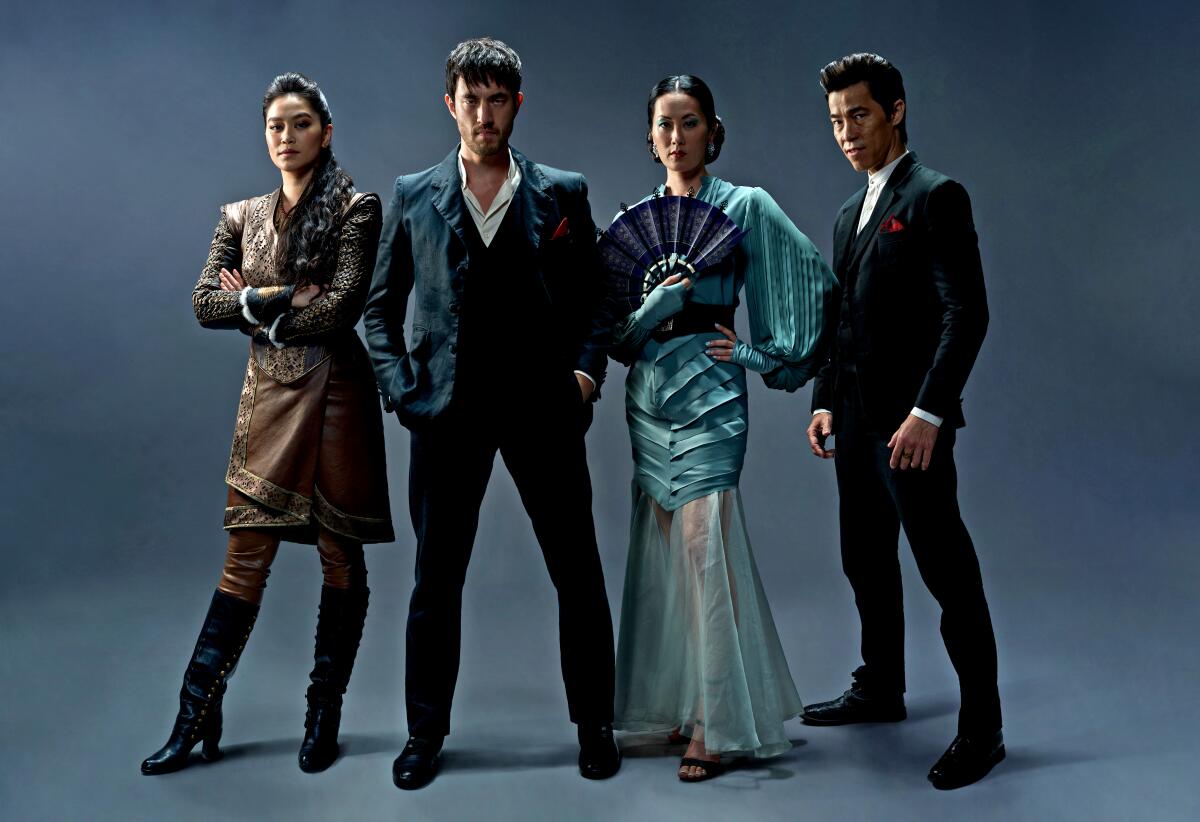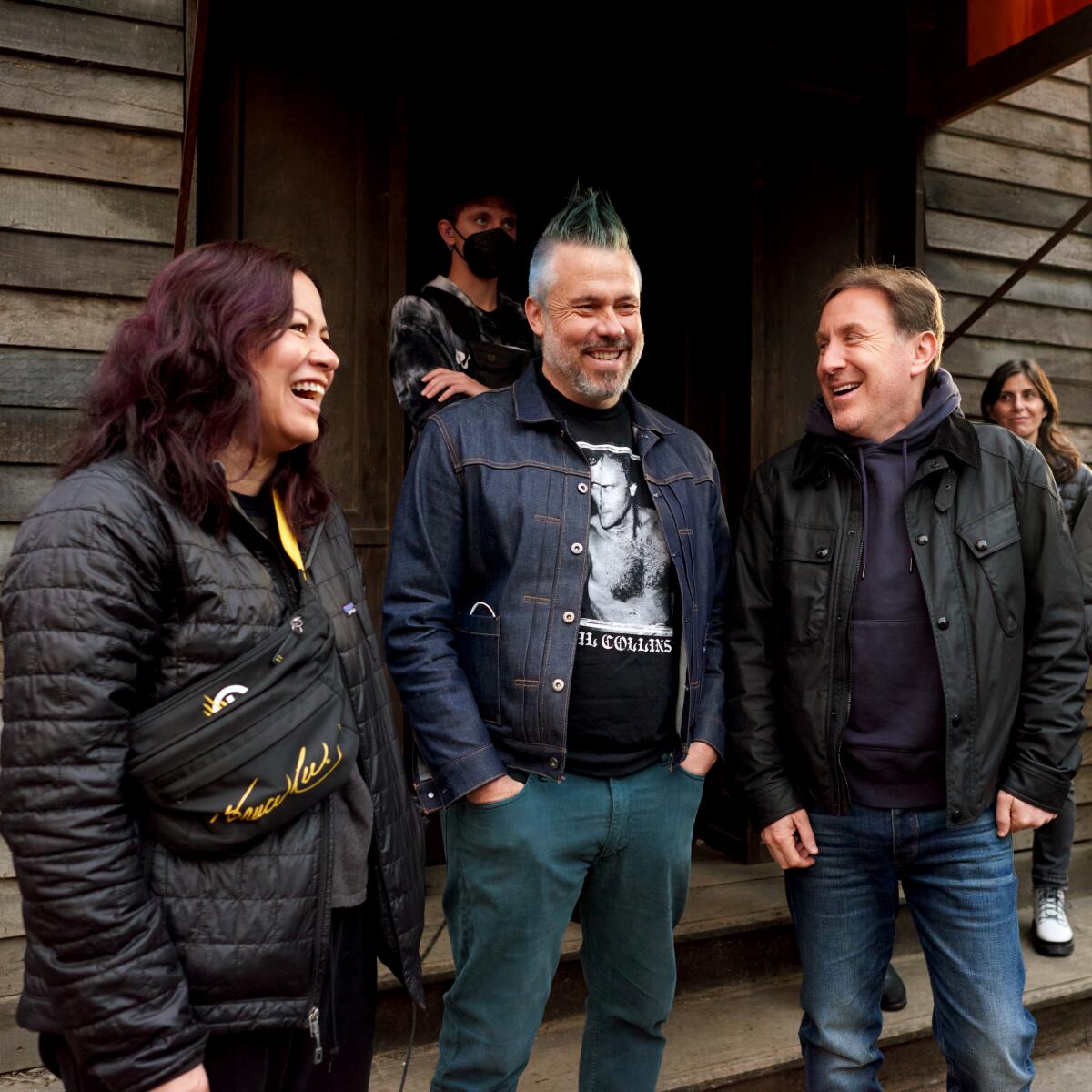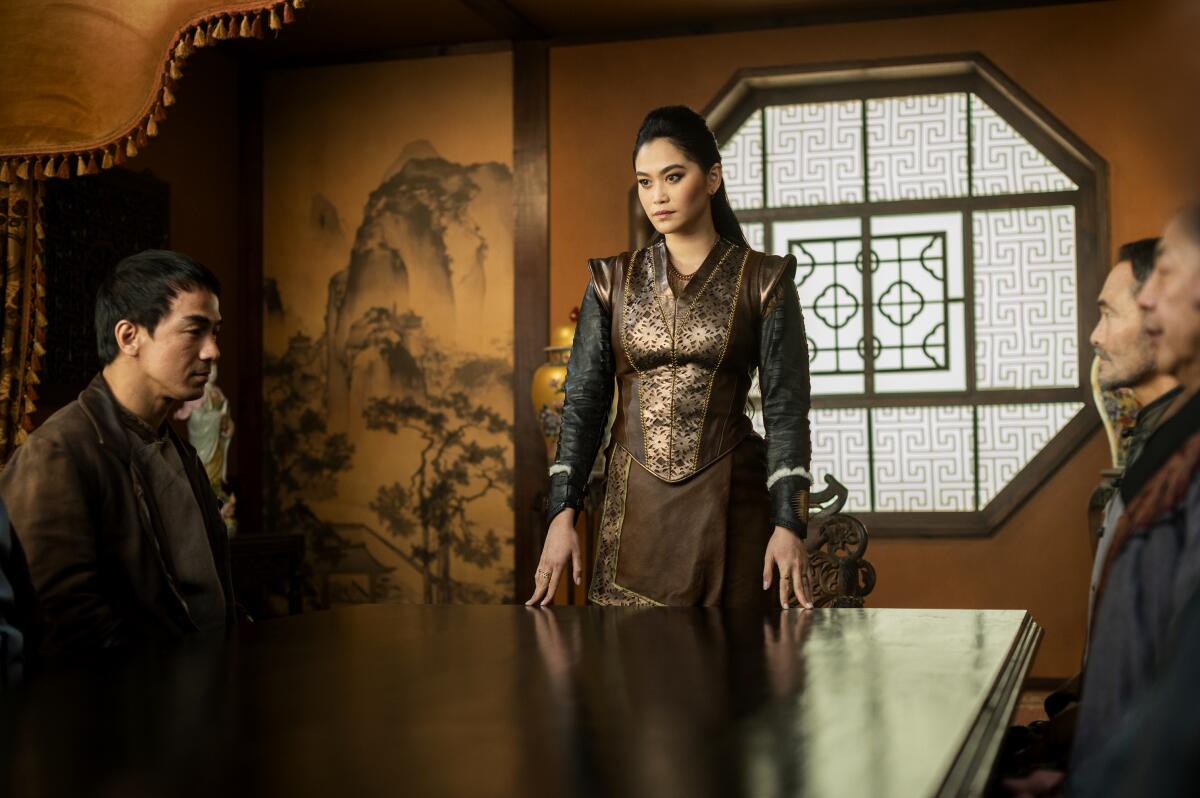‘Warrior,’ the underdog series based on Bruce Lee’s vision, returns for Season 3

- Share via
Shannon Lee has long safeguarded her father’s legacy — she’s the only surviving child of Bruce Lee. The martial artist and actor was not only one of the most visible Asian Americans in Hollywood during the 1960s and ’70s, he was a pop culture icon. His status was further cemented when he died unexpectedly at 32.
Over the years, numerous people have approached Shannon Lee with creative projects based on her father, but she said they were mostly looking to capitalize on his image. She wanted to be involved in order to protect his legacy, but Lee found herself being shut out time and time again. It wasn’t until producer Justin Lin asked her about creating a show, based on a pitch her father had made 45 years ago, that the seeds were planted for the martial arts drama “Warrior.”
“Justin said to me, ‘We should make this show but only make it if we can do justice to your father’s legacy,’“ Lee told The Times. “That was just music to my ears.”
And “Warrior” has everything a Bruce Lee fan could want — it’s chock-full of highly choreographed and gory fight scenes, scintillating drama and backstabbing politics.
The first two seasons of the series, which aired on Cinemax, follow the journey of Ah Sahm (Andrew Koji), a martial artist from China, who emigrates to San Francisco in the 1870s and becomes entangled in the rivalries of the tongs, or Chinese gangs, as he becomes a member of the Hop Wei. The show weaves in historical elements — like the madame and prostitute Ah Toy, played by Olivia Cheng, and the anti-Chinese sentiment during the time — to create a drama full of intrigue and espionage with western-style gunslinging action.
However, in 2020, Cinemax announced it would cease production of original shows, effectively canceling the series. But a year later, HBO Max (Max as of May) announced that it was picking up the series for a third season, thanks in part to a grassroots campaign by fans of the show. Season 3 of “Warrior” is now streaming on Max, three years after the Season 2 release.

Jonathan Tropper, the creator of the series and the showrunner for the first two seasons, said its survival has felt like the battle of a scrappy fighter winning against all odds — not unlike the show’s main character. The producers had to get creative with their budget, which included crafting a set in Cape Town, South Africa, where it’s cheaper to film, and shooting with a graphic novel aesthetic — gritty and dark without the expensive, panoramic establishing shots one might typically see in a blockbuster action flick.
“The show got made under challenging circumstances and then we didn’t have a Season 3, but somehow everyone sort of stuck to it,” Tropper said. “There’s a certain underdog, scrappy quality that feels very connected to Bruce Lee and the fact that our third season is airing at the 50th anniversary of his legacy.”
Nuanced portrayals of Asians
“Warrior” features a mostly Asian cast, and it made a reality of Bruce Lee’s vision for more accurate and nuanced portrayals of Asian Americans in Hollywood. When “Warrior” launched in 2019, predominantly Asian casts onscreen were few and far between, but things were starting to change. “Crazy Rich Asians” had just been released the year before and featured an all-Asian cast. Both helped lay the groundwork for more films and series to be led by Asian actors, including “Shang-Chi and the Legend of the Ten Rings,” “Everything Everywhere All at Once” and “Beef.”
Jason Tobin, who plays Young Jun, the hot-headed, dagger-wielding leader of the Hop Wei, and Joe Taslim, who plays Li Yong, the leading fighter from the opposing Long Zii tong, star alongside Koji. The actors are dominant, powerful and sexy as the men who operate the criminal underground of San Francisco’s Chinatown and in the countless scenes where they fight, skin glistening and muscles rippling.
Tobin often plays the foil to Koji’s Ah Sahm, with their clashing leadership styles in the Hop Wei. Because each character has nuances, Tobin said he and Koji aren’t preoccupied with burdens like dismantling Asian stereotypes.

“I never think as Young Jun, ‘I need to play an Asian man,’” Tobin told The Times. “If you watch any kind of Asian cinema, there are men of all kinds. Sometimes we watch Western films on TV, you see Asian men and it’s very stereotypical.”
The second season of the show aired during the pandemic, and there were similar parallels, like how the show portrayed anti-Chinese sentiment in the 1850s and the rise in 2020 in violent attacks and racist rhetoric against Asians, who were scapegoated for the spread of COVID-19. As an Asian American watching this show during the pandemic, I found there was something cathartic about watching other Asians fight racism onscreen through brute force. It felt oddly just because in the timeline of the series, the specter of the 1882 Chinese Exclusion Act looms.
For the record:
10:51 a.m. July 2, 2023An earlier version of this story said Dianne Doan is Filipino. She is Canadian with Vietnamese ancestry.
For Hoon Lee, who plays Wang Chao, a dealer and go-to fixer in Chinatown in the series, the importance of the representation was not lost on him. Lee is Korean, and the show features actors from a range of East and Southeast Asian backgrounds, though the characters are largely Chinese American. (Dianne Doan, who plays Mai Ling, is Canadian with Vietnamese ancestry, Taslim is Indonesian, Koji is Japanese and British.) “Warrior” is a way to humanize Asians at a time of heightened hate, he said.
“When racial hatred flares up, as it has historically forever, you sometimes have the question about whether what you’re doing is enough,” Lee said. “And at the end of the day, stories are one of the most effective ways for people to absorb and think about the effect that these incidents have on human lives.”
Women drive the plot
“Warrior” isn’t just all action and fight scenes. The political machinations of the characters drive the narrative, and we begin to understand their complex motivations and the hidden secrets of each person. Season 3 explores more of that; we see Doan’s character, Mai Ling, vying for power as the leader of the Long Zii. Doan starts to set her eyes on the politics and resources outside of Chinatown to preserve and grow her influence.
Doan argues that the women drive the show’s plot. “Let’s also be honest, without Ah Toy and Mai Ling, the men would be lost and useless.”

Cheng plays Ah Toy, who is also a swordmaster who protects her brothel and the women who work there. While she knows that a character like hers, which is based on a real person, isn’t necessarily historically accurate, it offers a chance to flesh out the backstories of Chinese women who were criminalized as prostitutes in that era.
“We’d like to think that the women of that time, despite the systems and the subversion that they had to live through, were able to find some acts of agency and autonomy, and I feel like our show takes that idea and fulfills it to the extreme,” Cheng said about her and Doan’s characters. When the two women appear onscreen together, there’s an unspoken and tacit acknowledgment that they’re both looking out for each other in a world of powerful and dangerous men.
“Someone like Ah Toy could very well have been a two-dimensional trope,” Cheng added. “But the writers gave me something to play in making her complex, nuanced and all kinds of shades of gray.”

And that’s exactly how Evan Endicott and Josh Stoddard, the writers and showrunners for Season 3, keep viewers invested in an ensemble cast with a dozen characters — by showing everyone’s flaws and aspirations; no one character is the hero or the villain.
At this point in the series, there’s a camaraderie on set and an attention to detail that makes every scene pop, whether in the grime-filled streets of San Francisco or in Mai Ling’s elaborate cheongsams that emphasize her wealth and elegance.
“We made sure we had all the lettuce on the street that was missing — the streets were looking too clean,” Endicott jokes. “I found that the little details you’re talking about are what ultimately make the world real to the viewer.”
The future of the series
The show had the potential to become a hit, but its audience growth was stymied in part because of Cinemax’s limited subscriber base (Cinemax is owned by HBO). After the first two seasons started streaming on HBO Max, Joey Chavez, the drama programming executive at the platform, took notice of the show’s fan base, which wouldn’t stop talking about the show online. It’s ultimately why the network decided to greenlight a third season of “Warrior.”
“This is exactly the kind of show that people don’t become casual fans,” Chavez said. “And we just didn’t want something this quality to fall through the cracks.”
Though their roles haven’t launched Tobin and Koji to superstardom in Hollywood just yet, they’ve been committed to growing their craft and prowess as artists on the series. For Koji, he’s immensely grateful to be able to reprise his role for a third season, against all odds.

“I get Asian Americans telling me how important the show is to them,” the U.K.-based actor said of when fans approach him in the U.S. “We’re still not there yet, in terms of representation, in terms of true equality. There’s still a lot of internal institutionalized unspoken racial bias.” But Koji is undeterred and said he’s simply glad to be a part of the change that “Warrior” is leading in representation.
It’s too soon to know if the show will get a fourth season, particularly with factors like the writers’ strike and the all too common cancellations of series on streaming platforms. Koji is optimistic. “I hope that we get to end the show on our terms.”
Tropper isn’t too concerned, as he looks back on production of the third season. He said he has hope that the larger viewership on Max’s platform will draw in new audiences and that Season 3 will further demonstrate that “Warrior” isn’t just a niche show for Asians. “It was such a pleasure to see what we made because I do think it’s the best season yet.”
More to Read
The complete guide to home viewing
Get Screen Gab for everything about the TV shows and streaming movies everyone’s talking about.
You may occasionally receive promotional content from the Los Angeles Times.







